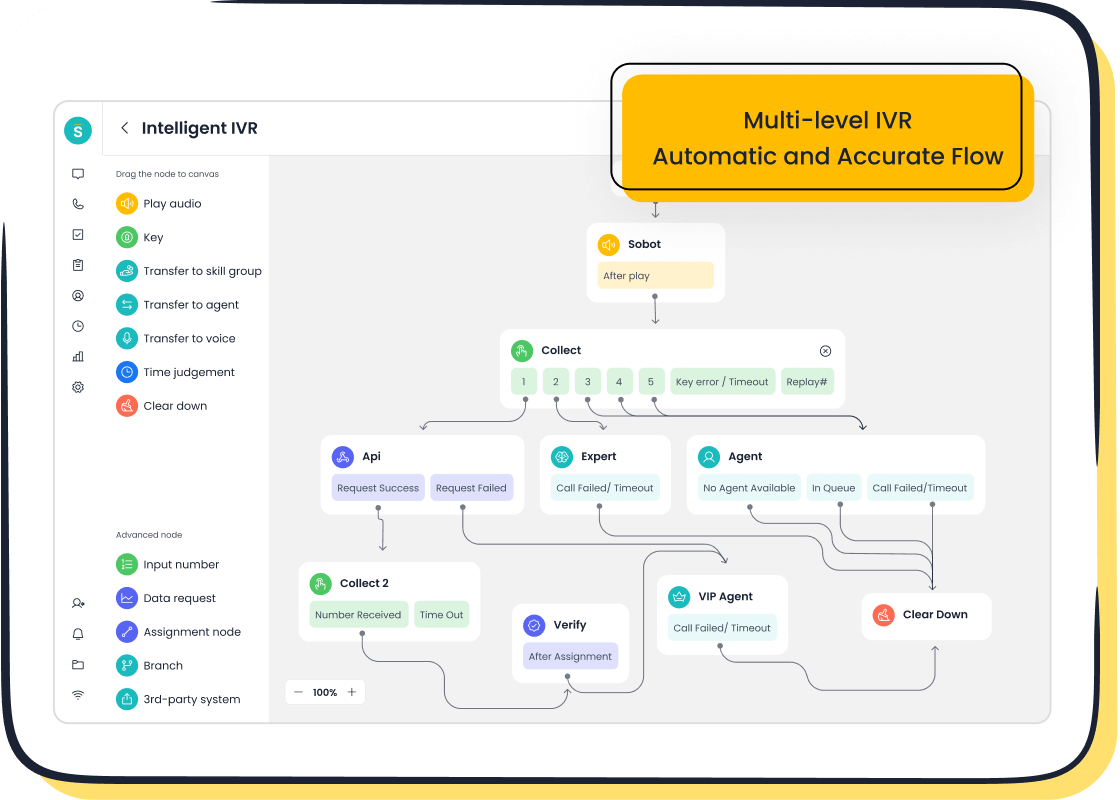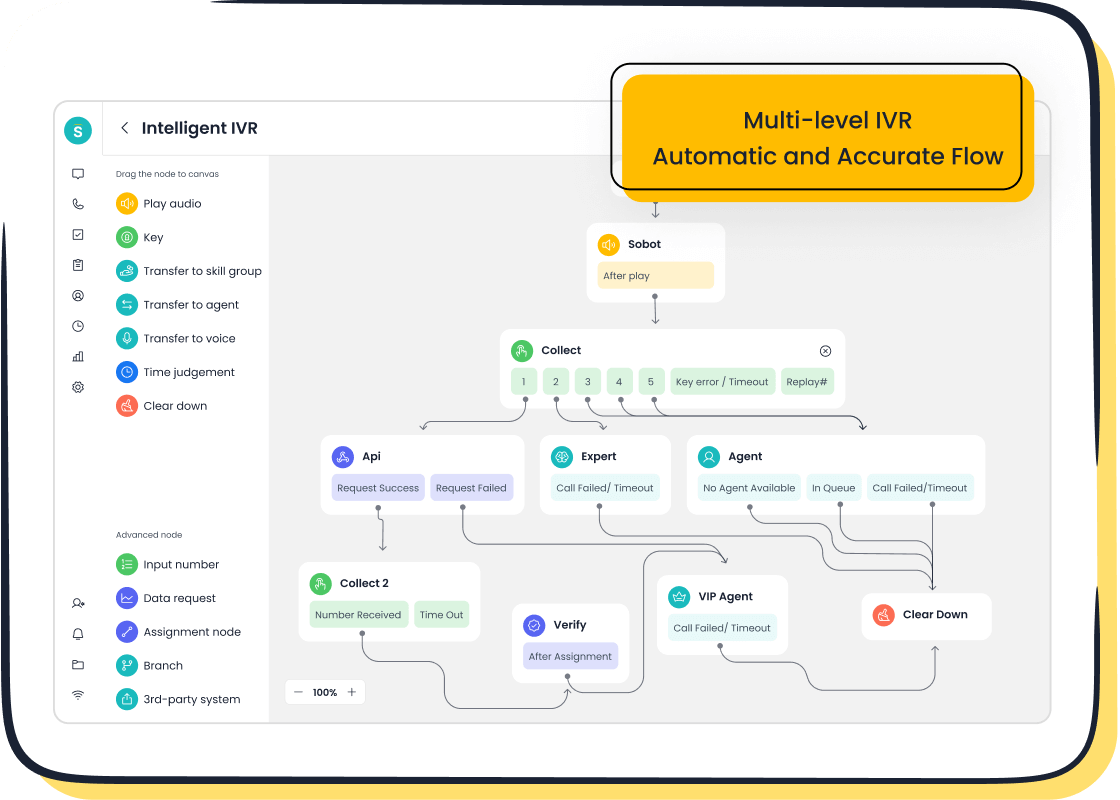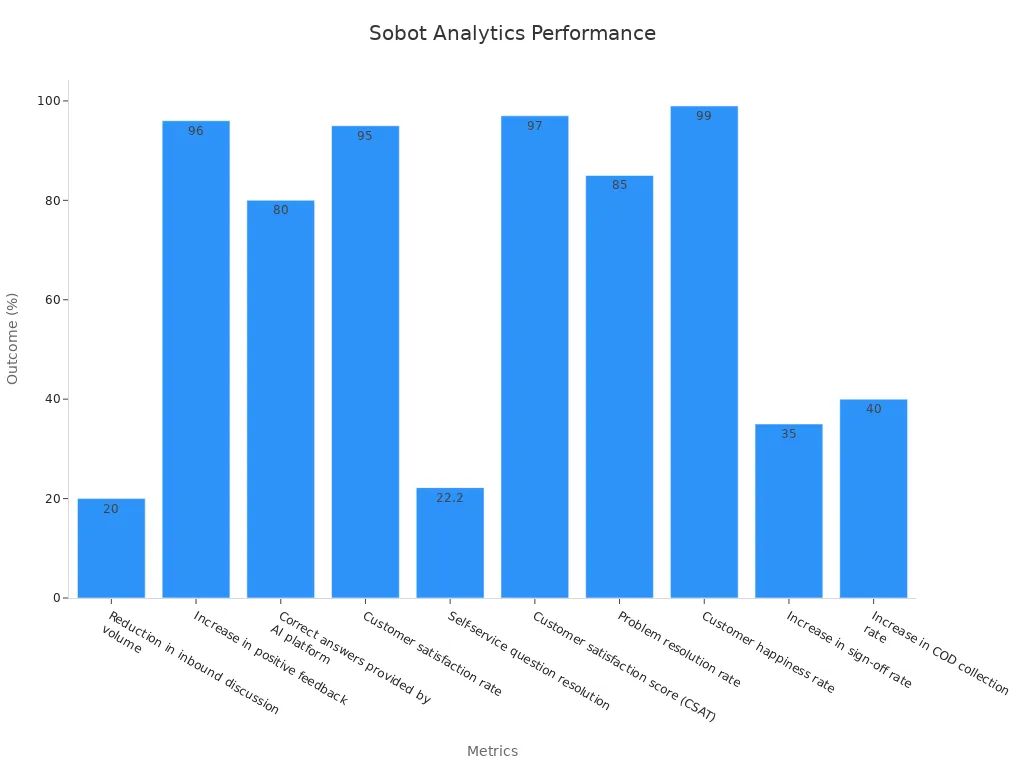Best Practices for Multi-Channel Contact Center Analytics

Modern customer service thrives on multi-channel contact centre analytics. Leveraging these analytics allows businesses to enhance customer experience and boost operational efficiency. Advanced tools like AI and real-time monitoring enable companies to personalize customer interactions and streamline processes effectively. For instance, organizations that extensively utilize analytics are 23 times more likely to outperform competitors in customer acquisition. This data-driven strategy empowers informed decision-making, ensuring seamless service delivery. Sobot’s solutions, trusted by global brands, offer the essential tools to harness multi-channel contact centre analytics, elevating customer service quality while driving cost savings and operational efficiency.
Understanding Multi-Channel Contact Center Analytics

What Is Multi-Channel Contact Center Analytics?
Multi-channel contact center analytics involves collecting and analyzing data from customer interactions across various communication channels. These channels include voice calls, emails, live chat, social media, and messaging apps. By consolidating this data, businesses gain a unified view of customer behavior and preferences.
Key components of multichannel analytics include:
- Unified Agent Interface: A centralized dashboard for managing interactions across all channels.
- Real-time Analytics: Instant insights into performance metrics for quick decision-making.
- CRM Integration: Access to customer history for personalized service.
- Intelligent Routing: Directing inquiries to the most suitable agent based on skills and availability.
This approach enables businesses to tailor their strategies and deliver seamless customer experiences.
Why Multi-Channel Analytics Is Essential for Customer Service
In today’s fast-paced world, customers expect personalized and efficient service. Multichannel analytics helps you meet these expectations by providing actionable customer insights. For example, 66% of consumers would stop engaging with a brand if their experience isn’t personalized. This figure rises to 75% among Gen Z consumers.
By analyzing data from multiple channels, you can identify trends, predict customer needs, and adjust your approach. Omnichannel analytics ensures consistency across platforms, making it easier to build trust and loyalty. It also empowers agents with the tools they need to resolve issues quickly, enhancing overall satisfaction.
Key Benefits of Multichannel Analytics for Businesses and Customers
Implementing multichannel analytics offers numerous advantages:
- Enhanced Customer Experience: Omnichannel solutions ensure customers receive consistent and personalized service, regardless of the channel they use.
- Improved Operational Efficiency: Real-time analytics and intelligent routing reduce response times and optimize resource allocation.
- Data-Driven Decision Making: Insights into customer behavior help you refine strategies and improve outcomes.
- Increased Customer Retention: Personalized interactions foster loyalty, encouraging repeat business.
For instance, businesses using omnichannel contact center solutions can create detailed buyer personas. These personas reveal preferences and buying habits, enabling marketing teams to target the right audience effectively. This approach not only improves customer satisfaction but also drives conversions.
Challenges Without Multi-Channel Analytics
Fragmented Customer Data Across Channels
When customer data is scattered across multiple platforms, it creates significant challenges for your business. Customers often interact through various channels like email, social media, and voice calls. Without a unified system, these interactions remain isolated, leading to fragmented customer profiles. This disconnection forces customers to repeat their concerns across channels, which frustrates them and reduces loyalty.
- Channel fragmentation often results in inconsistent service experiences, leaving customers dissatisfied.
- 63% of customers use more than one channel to interact with their insurance providers, highlighting the need for a holistic approach.
- Operational inefficiencies arise when teams handle channels in silos, increasing costs and duplicating efforts.
Disconnected data also limits your ability to understand customer behavior. Without a complete view, personalizing marketing efforts becomes difficult. This can lead to generic messaging that fails to resonate with your audience, ultimately causing missed opportunities and revenue loss.
Inconsistent Multichannel Customer Service Experiences
Without integrated analytics, delivering consistent multichannel customer service becomes a challenge. Customers expect the same level of service across all platforms, but independent channel operations often result in disjointed experiences. For example, a customer might receive quick responses on live chat but face delays on email. These inconsistencies can harm your brand reputation and drive customers to competitors.
- Tracking campaign success across channels becomes difficult without analytics integration.
- Weak integration between platforms creates a fragmented customer journey.
- Maintaining a unified brand voice across channels becomes nearly impossible when each operates separately.
By failing to provide a seamless experience, you risk losing customer trust. Integrated analytics ensures that every interaction aligns with your brand’s standards, fostering loyalty and satisfaction.
Limited Insights into Agent Performance
The absence of multichannel analytics makes it harder to evaluate agent performance effectively. Without structured data, you cannot measure key metrics like productivity or customer satisfaction accurately. This lack of insights can hinder your ability to identify areas for improvement.
- Siloed systems prevent you from gaining a comprehensive view of agent performance.
- Overwhelming volumes of unstructured data make it challenging to assess productivity.
- Agents may lack the training to interpret data, limiting their ability to improve.
Metrics like Average Handle Time (AHT) and quality monitoring become less meaningful without context from multichannel analytics. By integrating analytics, you can provide agents with actionable insights, enabling them to deliver better service and improve operational efficiency.
Missed Opportunities for Proactive Customer Engagement
Failing to leverage multi-channel analytics can result in missed opportunities to engage with your customers proactively. Without actionable insights, you may struggle to anticipate customer needs or address their concerns before they escalate. This reactive approach often leaves customers feeling undervalued, which can harm your brand's reputation.
Proactive engagement relies on understanding customer behavior and preferences. Analytics help you identify patterns, such as frequent complaints or recurring inquiries. Without these insights, your customer service may become generic and fail to meet individual needs. For example, a customer who frequently contacts your support team about a specific issue might benefit from a tailored solution. Without analytics, this opportunity could go unnoticed.
Tip: Use analytics to predict customer needs and offer solutions before they ask. This builds trust and loyalty.
Missed analytical insights can have far-reaching consequences:
- Generic customer service fails to address individual needs effectively.
- Critical customer preferences and pain points may go unnoticed.
- Uncaptured feedback limits your ability to adapt and improve.
These gaps reduce your ability to create meaningful connections with your audience. Proactive engagement also drives customer satisfaction and retention. For instance, sending personalized recommendations or resolving issues before customers report them can significantly enhance their experience.
By integrating analytics into your operations, you can transform customer interactions. Tools like Sobot’s omnichannel solutions provide real-time insights, enabling you to act swiftly and strategically. This approach not only improves customer satisfaction but also strengthens your competitive edge.
Best Practices for Implementing Multi-Channel Contact Center Analytics
Build Comprehensive Customer Profiles
Building comprehensive customer profiles is one of the most effective ways to optimize your multichannel contact center. These profiles consolidate data from all communication channels, providing a 360-degree view of each customer. By doing so, you can deliver personalized and consistent service across every touchpoint.
- Customer Service: Detailed profiles allow your service teams to access customer histories and preferences. This improves issue resolution and fosters loyalty.
- Sales: Tailored sales approaches based on customer data lead to higher conversion rates and retention.
- Product Development: Feedback and usage data from profiles help refine products, increasing engagement.
- Cross-Channel Personalization: Profiles ensure seamless experiences across channels, enhancing the customer journey.
- Predictive Analytics: Anticipating customer needs enables proactive engagement and personalized offers.
For example, Sobot’s omnichannel contact center solutions unify customer data from voice, email, and social media. This integration empowers your agents to provide tailored support, improving satisfaction and loyalty. By leveraging these profiles, you can also identify trends and refine your strategies for better outcomes.
Use Real-Time Analytics for Immediate Decision-Making
Real-time analytics is a game-changer for multichannel contact centers. It provides instant insights into customer interactions, enabling you to make informed decisions on the spot. This approach not only enhances operational efficiency but also improves customer satisfaction.
| Metric | Benefit |
|---|---|
| Real-time Sentiment Analysis | Detects customer emotions, enabling agents to adjust their approach based on feedback. |
| Automated Alerts | Sends notifications for long wait times or negative sentiment, prompting immediate action. |
| Performance Insights | Provides immediate data to identify trends and improve operational efficiency. |
| Metric | Benefit |
|---|---|
| Average Handle Time | Helps in monitoring efficiency and reducing customer wait times. |
| First-Call Resolution | Increases customer satisfaction by resolving issues on the first contact. |
| Call Volume | Assists in resource allocation and managing agent workload effectively. |
For instance, Sobot’s real-time analytics tools allow you to monitor key metrics like call volume and sentiment analysis. These insights help you allocate resources effectively and address customer concerns before they escalate. By acting on real-time data, you can ensure a smooth and efficient customer experience.
Train Agents to Leverage Analytics Tools Effectively
Your agents play a crucial role in implementing multichannel analytics. Proper training ensures they can use analytics tools to their full potential, improving both individual performance and overall customer satisfaction.
- Call Volumes: Higher activity often indicates better skill development.
- Customer Satisfaction Scores: Measuring interaction quality highlights areas for improvement.
- Training Completion Rates: Successful engagement with learning modules reflects effective training.
- Average Handling Time: Efficiency levels reveal where targeted coaching is needed.
Sobot’s contact center solutions include user-friendly analytics tools that simplify agent training. For example, the unified workspace consolidates customer data, making it easier for agents to access relevant information. By equipping your team with the right tools and training, you can enhance their ability to deliver exceptional service. This not only boosts customer satisfaction but also improves operational efficiency.
Tip: Regularly update training programs to keep agents informed about new tools and features. This ensures they stay ahead in delivering top-notch service.
Integrate Analytics with CRM and Omnichannel Solutions
Integrating analytics with CRM and omnichannel solutions is essential for delivering seamless and personalized customer experiences. By combining data from various sources, you can gain a deeper understanding of customer needs and behaviors. This integration allows you to unify customer interactions across channels, ensuring consistent service and engagement throughout the customer journey.
- Enhanced Customer Understanding: Consolidating data from CRM and omnichannel platforms provides a 360-degree view of customer preferences and pain points. This enables you to tailor your approach and address specific needs effectively.
- Dynamic Interaction Analysis: Linking analytics with CRM allows you to correlate customer sentiment with sales performance. For example, analyzing feedback from live chat alongside purchase history can reveal valuable insights into buying patterns.
- Improved Engagement: Omnichannel solutions ensure customers receive consistent communication, whether they interact via email, social media, or voice calls. This consistency builds trust and fosters loyalty.
- Performance Verification: Integrating analytics with CRM enables you to verify survey feedback by linking it with interaction details. This provides a clearer picture of agent performance and helps identify areas for improvement.
Sobot’s omnichannel solutions excel in this area by unifying customer interactions across platforms like WhatsApp, email, and voice. These tools integrate seamlessly with CRM systems, empowering your team to deliver personalized and efficient service. For instance, Sobot’s unified workspace consolidates customer data, enabling agents to access relevant information instantly. This not only enhances customer satisfaction but also streamlines operations.
Tip: Use real-time analytics to monitor customer interactions and adjust your strategies dynamically. This ensures you stay ahead of customer expectations and deliver exceptional service.
Continuously Monitor and Optimize Analytics Strategies
To maximize the benefits of multichannel analytics, you must continuously monitor and optimize your strategies. This involves tracking key metrics, identifying trends, and making data-driven adjustments to improve performance over time. Industries like finance, e-commerce, and healthcare have demonstrated the value of this approach.
| Industry | Example of Continuous Monitoring Strategy | Outcome |
|---|---|---|
| Finance | High-frequency trading firms use real-time monitoring for market data feeds and trading volumes. | Prompt detection of anomalies, enabling immediate corrective actions to avoid losses. |
| E-Commerce | Major retailers monitor website uptime and transaction processing rates. | Quick identification of performance issues, ensuring uninterrupted service for customers. |
| Healthcare | Healthcare providers monitor EHR system availability and data integrity. | Early detection of security breaches, maintaining patient data confidentiality and integrity. |
Incorporating continuous monitoring into your analytics strategy ensures you can adapt to changing customer needs and market conditions. For example, tracking metrics like Average Handle Time (AHT) and First-Call Resolution (FCR) helps you identify bottlenecks and optimize workflows. Regular audits of your analytics tools and data quality also ensure accuracy and reliability.
Sobot’s solutions support continuous monitoring by providing real-time analytics and performance insights. These tools allow you to track key metrics, identify trends, and make informed decisions. For instance, Sobot’s AI-powered voicebot can analyze call data in real time, enabling proactive engagement and faster issue resolution. By leveraging these capabilities, you can enhance customer satisfaction and maintain a competitive edge.
Note: Regularly review your analytics strategies to ensure they align with your business goals. This helps you stay agile and responsive in a dynamic market environment.
Tools and Technologies for Multi-Channel Analytics

Overview of Analytics Platforms for Multichannel Contact Centers
Analytics platforms for multichannel contact centers play a pivotal role in modern customer service. These platforms collect and analyze data from various communication channels, such as phone calls, live chats, emails, and social media. By consolidating this data, they provide actionable insights that enhance customer interactions and improve agent performance.
For example, real-time reporting allows you to monitor ongoing interactions and address issues immediately. Predictive analytics helps you anticipate customer needs, enabling proactive engagement. These tools also refine service strategies by identifying trends and patterns in customer behavior. As a result, businesses can boost customer satisfaction and loyalty while optimizing operational efficiency.
By adopting a robust analytics platform, you can unify your multichannel operations and deliver a seamless customer experience. Sobot’s omnichannel solutions exemplify this by integrating data from multiple touchpoints into a single, user-friendly interface. This approach ensures consistency across channels and empowers your team to make data-driven decisions.
Features to Look for in Analytics Tools
Choosing the right analytics tool for your multichannel contact center requires careful consideration of its features. The following table highlights essential attributes to look for:
| Feature | Description |
|---|---|
| Intuitive interface | The tool should be easy to navigate, allowing users to quickly understand and use its features. |
| Adaptable dashboards | The ability to customize dashboards ensures that users can focus on the metrics that matter most. |
| Scalable architecture | As your business grows, the tool should handle increased data loads and user numbers without issues. |
| Rich data visualization | Effective data visualization options help in making complex data easily digestible. |
| Versatile data integration | Seamless integration with other software and data sources is crucial for comprehensive analytics. |
| Collaborative features | Tools that support teamwork by enabling easy sharing and commenting on reports enhance decision-making. |
| Robust security | Ensuring data protection through encryption and compliance with standards is essential. |
| Dependable support | Access to knowledgeable customer support is invaluable for troubleshooting and optimizing tool use. |
When evaluating tools, prioritize those that align with your business needs. For instance, if your contact center handles high call volumes, look for features like scalable architecture and real-time reporting. If your team collaborates frequently, choose a tool with strong collaborative features. Sobot’s omnichannel solutions offer many of these capabilities, ensuring a comprehensive and secure analytics experience.
Tip: Always test the tool’s interface and customization options before committing. This ensures it meets your team’s requirements and enhances productivity.
Role of AI and Machine Learning in Multichannel Analytics
Artificial intelligence (AI) and machine learning (ML) have revolutionized multichannel analytics by automating processes and uncovering deeper insights. These technologies analyze vast amounts of data quickly, identifying patterns and trends that would be difficult to detect manually.
AI-powered tools, like Sobot’s voicebot, enhance customer interactions by recognizing intent and providing accurate responses. Machine learning algorithms predict customer behavior, enabling you to offer personalized recommendations and proactive solutions. For example, sentiment analysis uses AI to gauge customer emotions during interactions, helping agents adjust their approach in real time.
Here’s how AI and ML contribute to multichannel analytics:
- Automation: AI automates repetitive tasks, such as data entry and report generation, freeing up your team for more strategic activities.
- Predictive Insights: ML models analyze historical data to forecast trends, allowing you to prepare for future customer needs.
- Enhanced Personalization: AI tailors interactions based on customer preferences, improving satisfaction and loyalty.
- Real-Time Adaptation: AI-driven tools adjust strategies dynamically, ensuring optimal performance across all channels.
By integrating AI and ML into your analytics strategy, you can transform your contact center into a proactive and efficient operation. Sobot’s omnichannel solutions leverage these technologies to deliver real-time insights and personalized experiences, helping you stay ahead in a competitive market.
Note: Regularly update your AI models with fresh data to maintain accuracy and relevance in your analytics.
Sobot's Voice/Call Center and Omnichannel Solutions for Analytics

Sobot’s Voice/Call Center and Omnichannel Solutions provide powerful tools to elevate your multi-channel contact center analytics. These solutions help you unify customer interactions, analyze data effectively, and deliver exceptional service across all communication channels. By leveraging advanced features like AI-powered analytics and real-time monitoring, you can transform your customer service operations.
Key Features of Sobot's Voice/Call Center
Sobot’s Voice/Call Center offers a range of features designed to optimize your analytics and improve customer interactions:
- Intelligent IVR: Customize call flows and route inquiries to the right agents instantly.
- Real-Time Monitoring: Track call data and agent performance as it happens.
- AI-Powered Voicebot: Automate responses and recognize customer intent with high accuracy.
- Global Reach: Access phone numbers worldwide and ensure seamless communication.
- Unified Workspace: Consolidate customer data for a 360-degree view of interactions.
These features enable you to analyze customer behavior, reduce response times, and improve first-call resolution rates. For example, the AI-powered voicebot can handle repetitive queries, allowing agents to focus on complex issues.
Benefits of Sobot's Omnichannel Solutions
Sobot’s Omnichannel Solutions integrate all communication channels, such as email, social media, and live chat, into a single platform. This integration ensures consistent service and provides actionable insights through advanced analytics. Here’s how it benefits your business:
- Enhanced Customer Experience: Deliver personalized service by accessing unified customer profiles.
- Improved Efficiency: Automate repetitive tasks and allocate resources effectively.
- Data-Driven Decisions: Use analytics to identify trends and refine strategies.
- Proactive Engagement: Anticipate customer needs and address issues before they arise.
For instance, Sobot’s unified workspace allows agents to access customer history instantly, ensuring seamless interactions across channels.
Proven Results with Sobot's Solutions
Sobot’s solutions have delivered measurable success for businesses across industries. The following table highlights key outcomes achieved through its Voice/Call Center and Omnichannel Solutions:
| Metric/Outcome | Result/Statistic |
|---|---|
| Reduction in inbound discussion volume | 20% |
| Increase in positive feedback | 96% + |
| Correct answers provided by AI platform | Over 80% |
| Customer satisfaction rate | Over 95% |
| Self-service question resolution | 22.2% |
| Customer satisfaction score (CSAT) | 97% |
| Problem resolution rate | 85% |
| Customer happiness rate | 99% |
| Increase in sign-off rate | About 35% |
| Increase in COD collection rate | About 40% |
These results demonstrate the effectiveness of Sobot’s analytics-driven approach. Businesses using these solutions have seen significant improvements in customer satisfaction, operational efficiency, and revenue growth.

Why Choose Sobot for Multi-Channel Analytics?
Sobot’s solutions stand out for their reliability, scalability, and innovation. With a 99.99% system uptime and seamless integration capabilities, you can trust Sobot to support your business needs. Its AI-powered tools and omnichannel platform ensure you stay ahead in delivering exceptional customer service. By adopting Sobot’s solutions, you can harness the full potential of multi-channel analytics to drive success.
Tip: Start leveraging Sobot’s Voice/Call Center and Omnichannel Solutions today to transform your contact center into a data-driven powerhouse.
Tips for Monitoring and Improving Analytics Over Time
Define and Track Key Performance Indicators (KPIs)
Tracking the right KPIs ensures your multichannel contact center remains efficient and customer-focused. These metrics provide measurable insights into performance and help you identify areas for improvement. Start by defining KPIs that align with your business goals and customer journey. For example, Average Handling Time (AHT) measures how quickly agents resolve issues, while First Call Resolution (FCR) highlights the effectiveness of your service.
| KPI Name | Description |
|---|---|
| Average Handling Time (AHT) | Measures the average time taken to handle a customer interaction, including post-call work. |
| First Call Resolution (FCR) | Percentage of inquiries resolved during the first contact. |
| Customer Satisfaction (CSAT) | Gauges customer satisfaction post-interaction through surveys. |
| Service Level | Percentage of calls answered within a specified timeframe. |
| Abandonment Rate | Percentage of customers who disconnect before reaching an agent. |
| Occupancy Rate | Percentage of time agents spend handling interactions versus being available. |
| Customer Effort Score (CES) | Measures the effort required by customers to resolve issues. |
| Net Promoter Score (NPS) | Likelihood of customers recommending the company. |
| Customer Retention Rate | Percentage of customers who continue business over a period. |
Focus on KPIs that directly impact customer retention and satisfaction. Use tools like Sobot’s omnichannel solutions to monitor these metrics in real time. This approach ensures you stay proactive in improving the customer journey.
Tip: Regularly review your KPIs to ensure they reflect current business priorities and customer expectations.
Conduct Regular Data Audits and Quality Checks
Data audits and quality checks are essential for maintaining the accuracy and reliability of your analytics. Regularly assessing your data ensures you capture meaningful insights and avoid errors that could misguide your strategies. Customized KPI dashboards and trend analysis tools help you identify patterns in customer behavior and agent performance.
| Key Features of Data-Driven Quality Programs | Benefits of Data-Driven Quality Metrics |
|---|---|
| Customized KPI dashboards | Objective measurement: Provides unbiased view of performance |
| Trend analysis | Pattern identification: Reveals meaningful trends in customer and agent behavior |
| Performance benchmarking | Proactive improvement: Helps anticipate and prevent potential issues |
| Real-time monitoring of metrics | Evidence-based decisions: Supports strategic planning with concrete data |
Involve your agents in the process by updating scorecard criteria based on their frontline insights. Adapt these criteria to customer feedback, emphasizing qualities like empathy and accuracy. This collaborative approach ensures your analytics remain relevant and actionable.
Note: Use Sobot’s reporting tools to automate audits and monitor data quality consistently.
Leverage Customer Feedback to Refine Analytics Strategies
Customer feedback is a goldmine for refining your analytics strategies. Regularly collecting and analyzing feedback helps you understand pain points and track progress in improving the customer journey. Metrics like CSAT, NPS, and CES are directly influenced by how well you address customer concerns.
- Continuous feedback collection identifies recurring issues and highlights areas for improvement.
- Tracking customer effort reveals how easy it is for customers to resolve their problems.
- Positive feedback boosts retention by reinforcing trust and loyalty.
Use omnichannel tools to gather feedback across platforms like email, social media, and voice calls. For example, Sobot’s solutions enable you to integrate feedback seamlessly into your analytics, ensuring you capture actionable insights. This approach not only enhances customer satisfaction but also strengthens your ability to adapt to changing needs.
Tip: Act on feedback promptly to show customers their opinions matter. This builds trust and improves retention.
Stay Updated on Industry Trends and Innovations
Staying informed about industry trends and innovations ensures your contact center remains competitive. The analytics industry evolves rapidly, introducing new tools and strategies that improve customer service and operational efficiency. By adopting these advancements, you can enhance your multichannel operations and deliver exceptional experiences.
Here are some key trends shaping the analytics landscape:
| Trend/Innovation | Description |
|---|---|
| Integration of AI | Businesses are leveraging AI-powered features such as chatbots and predictive analytics to enhance efficiency. |
| Omnichannel Solutions | Contact center software enables seamless interaction across various channels like voice, email, and social media. |
| Focus on Data Analytics | Increasing emphasis on data analytics helps improve customer experience and operational efficiency. |
| Cost Optimization | Streamlining operations and reducing manual tasks through advanced software features. |
| Globalization Support | Advanced software supports multiple languages and time zones for international operations. |
| Regulatory Compliance | Built-in security features help businesses comply with data privacy regulations. |
Adopting omnichannel solutions is particularly vital. These platforms unify communication channels, ensuring customers receive consistent service whether they contact you via email, social media, or voice calls. This approach not only improves customer satisfaction but also simplifies agent workflows. For example, integrating AI into your omnichannel strategy can automate repetitive tasks, allowing agents to focus on complex issues.
Focusing on data analytics is another essential step. Analyzing customer interactions across multichannel platforms provides actionable insights. These insights help you identify trends, predict customer needs, and refine your strategies. Additionally, advanced analytics tools support cost optimization by reducing manual processes and improving resource allocation.
Globalization support is increasingly important for businesses operating in multiple regions. Tools that handle various languages and time zones ensure seamless communication with international customers. Moreover, regulatory compliance features protect customer data and build trust.
To stay ahead, regularly review industry reports and attend webinars or conferences. These resources provide valuable insights into emerging technologies and best practices. By embracing innovations like omnichannel solutions and AI, you can future-proof your contact center and maintain a competitive edge.
Tip: Partner with trusted providers like Sobot to access cutting-edge omnichannel solutions and analytics tools. This ensures your contact center remains efficient and customer-focused.
Multi-channel contact center analytics plays a vital role in delivering exceptional customer service. It helps you unify data from various platforms, enabling personalized and seamless experiences for your customers. By adopting best practices like building customer profiles, using real-time analytics, and integrating tools with CRM systems, you can optimize your multichannel operations. Tools like Sobot’s omnichannel solutions simplify this process by consolidating customer interactions and providing actionable insights. These solutions empower you to enhance efficiency, improve satisfaction, and stay ahead in a competitive market. Start leveraging analytics today to transform your contact center into a hub of excellence.
FAQ
What is multi-channel contact center analytics?
Multi-channel contact center analytics involves collecting and analyzing data from customer interactions across various channels like voice, email, and social media. It helps you understand customer behavior, improve service quality, and optimize operations. Tools like Sobot’s omnichannel solutions make this process seamless and efficient.
How does real-time analytics benefit customer service?
Real-time analytics provides instant insights into customer interactions. It helps you monitor agent performance, track key metrics like Average Handle Time (AHT), and address issues immediately. For example, Sobot’s real-time monitoring tools enable you to allocate resources effectively and improve customer satisfaction.
Why is integrating analytics with CRM important?
Integrating analytics with CRM unifies customer data, giving you a 360-degree view of interactions. This allows you to personalize service, predict customer needs, and ensure consistent experiences. Sobot’s omnichannel solutions integrate seamlessly with CRM systems, enhancing your ability to deliver exceptional service.
How can Sobot’s solutions improve multi-channel analytics?
Sobot’s solutions consolidate data from all communication channels into a unified workspace. Features like AI-powered voicebots, intelligent IVR, and real-time monitoring provide actionable insights. These tools help you enhance customer satisfaction, reduce response times, and optimize agent performance.
What industries benefit most from multi-channel analytics?
Industries like retail, financial services, and gaming benefit significantly. For instance, Sobot’s omnichannel solutions have helped companies like Opay improve customer satisfaction by 30% and reduce costs by 20%. These tools are versatile and adaptable to various business needs.
Tip: Explore Sobot’s omnichannel solutions to see how they can transform your contact center.
See Also
A Complete Guide to Establishing Omnichannel Contact Centers
Essential Insights on Omnichannel Call Center Software
Best Call Center Analytics Tools to Use in 2024
Enhancing Call Center Efficiency Through Effective Monitoring
